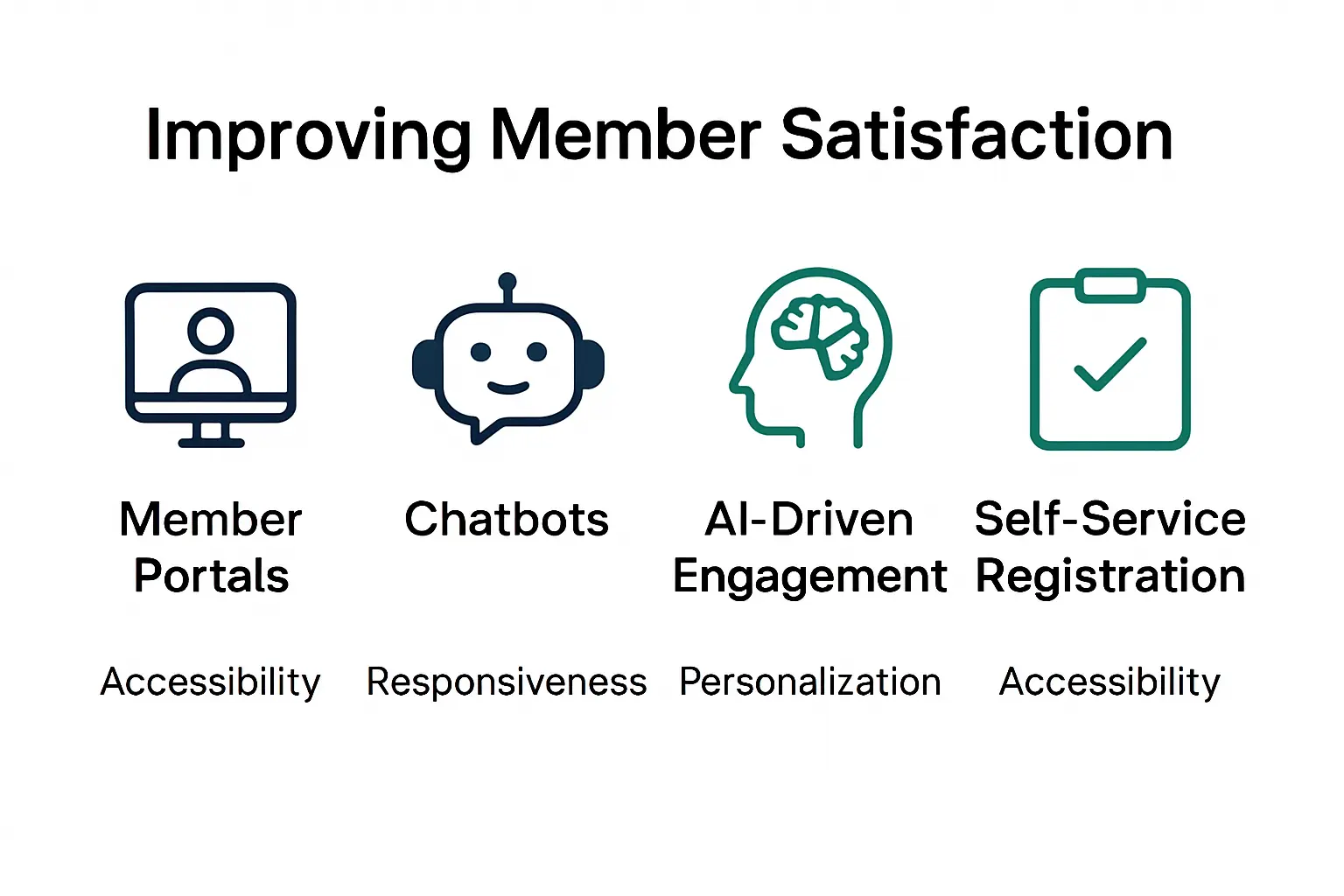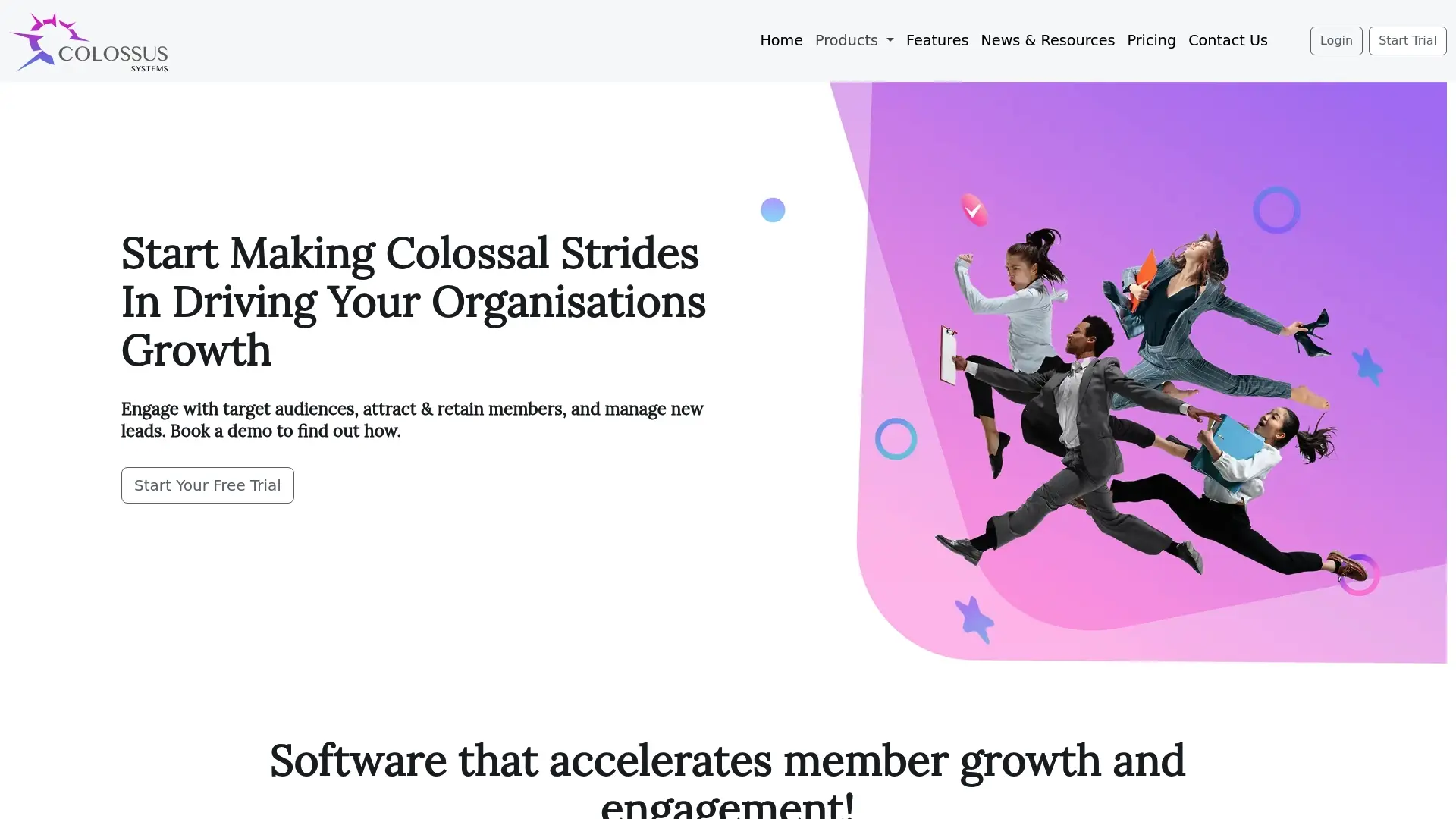Proven Strategies for Improving Member Satisfaction

Member satisfaction is more than a nice-to-have for organisations. It deeply influences retention and fuels long-term growth. Yet, most teams miss the mark by focusing only on perks and forget that internal communication alone can dramatically shape how members feel about their group, according to recent research. So while everyone rushes to roll out flashy features, the most effective changes start with understanding psychology and creating genuine dialogue. This flips the script on how true satisfaction is actually built.
Table of Contents
- Understanding What Drives Member Satisfaction
- Building Personalised Member Experiences
- Measuring and Acting on Member Feedback
- Leveraging Technology to Enhance Satisfaction
Quick Summary
| Takeaway | Explanation |
|---|---|
| Understand psychological needs for satisfaction | Recognise that member satisfaction extends beyond transactions to emotional and professional connections. |
| Implement effective communication strategies | Foster transparency and responsiveness to strengthen member relationships and trust within your organisation. |
| Leverage data for personalised experiences | Use data analytics to tailor content and interactions that resonate with members’ unique preferences and needs. |
| Actively seek and interpret feedback | Regularly collect, analyse, and implement feedback to continuously adapt and enhance member experiences. |
| Utilise technology to improve engagement | Integrate advanced technology, including AI, to create seamless, dynamic interactions and improve member satisfaction. |
Understanding What Drives Member Satisfaction
Member satisfaction represents a complex ecosystem of emotional, professional, and practical considerations that organisations must carefully navigate. At its core, satisfaction emerges from multiple interconnected factors that transform basic membership into a meaningful, engaging experience.
The Psychological Foundations of Member Engagement
Understanding member satisfaction requires a nuanced approach that goes beyond surface-level interactions. Research published in VOLUNTAS: International Journal of Voluntary and Nonprofit Organizations reveals that internal communication plays a pivotal role in shaping members’ perceptions and emotional connections with an organisation.
Professional associations and membership bodies must recognise that satisfaction is not merely transactional but deeply rooted in psychological needs. Members seek recognition, value, and a sense of belonging that transcends traditional service delivery. This means creating environments where individuals feel heard, respected, and integral to the organisation’s broader mission.
Communication and Responsiveness as Satisfaction Drivers
Effective communication emerges as a critical determinant of member satisfaction. Insights from BMC Health Services Research highlight that the quality of interaction significantly influences overall member experience. Key elements include:
- Transparency: Clear, consistent communication about organisational objectives and member benefits
- Responsiveness: Timely and personalised responses to inquiries and feedback
- Accessibility: Multiple channels for engagement and communication
Organisations must develop robust communication strategies that prioritise member perspectives. This involves not just broadcasting information but creating genuine dialogue mechanisms that allow members to feel genuinely connected and valued.
To highlight the different communication strategies that drive member satisfaction, the following table summarises the key features and benefits of each approach mentioned in the article.
| Communication Strategy | Key Features | Benefits to Members |
|---|---|---|
| Transparency | Clear, consistent updates about objectives and benefits | Builds trust and understanding |
| Responsiveness | Timely and personalised replies to enquiries and feedback | Members feel valued and heard |
| Accessibility | Multiple channels for engagement and communication | Easier and more comfortable access |
| Genuine Dialogue Mechanisms | Opportunities for two-way communication and member input | Enhanced sense of belonging |
Measuring and Evolving Member Satisfaction
Successful membership management requires continuous assessment and adaptation. Organisations need sophisticated approaches to understanding member needs, which might include:
- Regular satisfaction surveys
- Detailed feedback mechanisms
- Personalised engagement tracking
- Analysis of member interaction patterns
By treating member satisfaction as a dynamic, evolving construct, organisations can proactively address potential disconnects and create more meaningful membership experiences. The goal is not just retention but fostering a community where members feel genuinely invested in the organisation’s success.
Ultimately, member satisfaction represents a sophisticated interplay of emotional connection, professional value, and strategic communication. Organisations that master this delicate balance will not only retain members but transform them into passionate advocates and long-term partners.
Building Personalised Member Experiences
Personalisation has become a critical strategy for membership organisations seeking to create meaningful connections with their members. In an era of digital transformation, members expect tailored experiences that reflect their unique interests, professional goals, and engagement preferences.
Data-Driven Personalisation Strategies
Research from the Chambers of Commerce underscores the importance of leveraging data to craft individualised member experiences. By systematically analyzing membership data, organisations can develop sophisticated segmentation approaches that go beyond generic communication.
Key personalisation techniques include:
- Targeted Content Delivery: Creating customised email campaigns and newsletters that align with specific member interests
- Dynamic Member Portals: Developing interactive platforms that display personalised dashboards and recommended resources
- Behavioural Tracking: Monitoring engagement patterns to anticipate member needs and preferences
Tailoring Learning and Engagement Experiences
Insights from the Ohio Museums Association highlight the significance of understanding member behaviors to create meaningful interactions. Utilising advanced CRM and membership management tools enables organisations to develop sophisticated engagement strategies.
Effective personalisation requires continuous feedback loops. Regular surveys, interaction analysis, and member preference tracking allow organisations to refine their approach dynamically. This iterative process ensures that member experiences remain relevant and compelling.
Technology-Enabled Personalisation at Scale
Deloitte Insights emphasises the transformative potential of artificial intelligence and machine learning in creating personalised experiences. These technologies enable organisations to automate and optimize member interactions across multiple touchpoints.
Advanced personalisation platforms can:
- Determine optimal communication timing
- Select most relevant content channels
- Predict member interests and potential engagement opportunities
- Create adaptive communication strategies
By embracing these sophisticated approaches, organisations can move beyond one-size-fits-all models and create genuinely individualized member journeys. The goal is not just to provide information but to build meaningful, contextually relevant connections that make each member feel uniquely valued and understood.

Measuring and Acting on Member Feedback
Effective member feedback mechanisms are crucial for organisations seeking to continuously improve their services and maintain high levels of member engagement. By systematically collecting, analyzing, and implementing feedback, membership organisations can create responsive and dynamic environments that adapt to evolving member needs.
Developing Comprehensive Feedback Collection Strategies
The Community Tool Box emphasizes the importance of obtaining participant feedback throughout all program phases. This approach ensures that organisations can capture insights at critical points of member interaction.
Key strategies for robust feedback collection include:
- Multi-Channel Surveys: Designing surveys accessible through various platforms
- Open-Ended Questions: Allowing members to provide detailed, qualitative insights
- Periodic Pulse Checks: Implementing regular, short feedback mechanisms
- Anonymous Submission Options: Encouraging candid and unfiltered responses
Systematic Feedback Analysis and Interpretation
The UK Government’s Service Manual recommends a structured approach to analyzing member satisfaction data. This involves not just collecting feedback but developing sophisticated methods to interpret and translate insights into actionable strategies.
Effective analysis requires:
- Quantitative Metrics: Tracking numerical satisfaction scores
- Qualitative Assessment: Understanding underlying emotional and experiential factors
- Trend Tracking: Monitoring feedback patterns over time
- Segmentation Analysis: Breaking down feedback by member categories
Transforming Feedback into Organisational Improvement
Research published in the National Center for Biotechnology Information reveals that feedback interventions significantly impact participant satisfaction. Successful organisations view feedback not as a passive data collection exercise but as an active mechanism for continuous improvement.
Strategic implementation of feedback insights involves:
- Rapid prototyping of proposed changes
- Transparent communication about feedback-driven modifications
- Creating closed feedback loops where members see their input driving real change
- Establishing clear accountability for addressing member suggestions
By treating member feedback as a strategic asset, organisations can create dynamic, responsive environments that continuously evolve to meet changing member expectations. The goal is to transform feedback from a passive reporting mechanism into an active tool for organisational development and member engagement.
The following table organises the primary methods described for collecting, analysing, and acting on member feedback, providing a clear reference for each stage of the process and its main purposes.
| Stage | Methods & Tools | Purpose/Outcome |
|---|---|---|
| Feedback Collection | Multi-channel surveys, open-ended questions, pulse checks, anonymous options | Gather comprehensive, candid insights |
| Feedback Analysis | Quantitative metrics, qualitative assessment, trend tracking, segmentation | Identify trends and areas for improvement |
| Implementing Improvements | Rapid prototyping, transparent communication, closed feedback loops, accountability | Ensure changes based on member input |
Leveraging Technology to Enhance Satisfaction
Technology has become a transformative force in reimagining member engagement and satisfaction. Modern organisations are increasingly adopting sophisticated digital solutions that create more responsive, intuitive, and personalised member experiences.
Digital Platforms and Self-Service Solutions
Research from the U.S. Department of Education’s Digital Government Strategy highlights the critical importance of user-friendly digital platforms in enhancing customer satisfaction. These platforms enable members to access resources, manage their profiles, and interact with organisations seamlessly.
Key technological capabilities include:

- Interactive Member Portals: Providing 24/7 access to personalised information
- Automated Support Channels: Implementing intelligent chatbots for immediate query resolution
- Self-Service Registration: Streamlining event and membership management processes
- Mobile-Responsive Interfaces: Ensuring accessibility across multiple devices
Artificial Intelligence and Predictive Engagement
Insights from digital service innovation studies demonstrate how artificial intelligence can revolutionise member interactions. AI-powered systems can analyze member behaviour, predict preferences, and proactively suggest relevant resources and opportunities.
Advanced AI applications enable organisations to:
- Predict potential member churn
- Recommend personalised content and events
- Generate intelligent communication strategies
- Create dynamic member segmentation
Communication and Reflection Technologies
An innovative study exploring virtual mirroring techniques reveals how technology can enhance communication and self-reflection within organisational contexts. By implementing semantic analysis and intelligent feedback mechanisms, organisations can create more meaningful and responsive interaction environments.
Technological approaches to improving communication include:
- Real-time sentiment analysis
- Adaptive communication platforms
- Intelligent feedback aggregation
- Contextual communication routing
The future of member satisfaction lies in creating intelligent, adaptive digital ecosystems that understand and anticipate member needs. Technology is no longer just a support tool but a fundamental strategy for building deeper, more meaningful organisational relationships.
By embracing these technological innovations, organisations can transform traditional membership models into dynamic, responsive experiences that truly resonate with individual member expectations and aspirations.
Frequently Asked Questions
What are the key drivers of member satisfaction?
Member satisfaction is driven by several factors including effective communication, responsiveness, transparency, and a sense of belonging. Understanding psychological needs and fostering genuine dialogue are essential for enhancing satisfaction levels.
How can organisations personalise member experiences?
Organisations can personalise member experiences by leveraging data analytics to tailor content and interactions based on individual preferences. Techniques include targeted content delivery, dynamic member portals, and behavioural tracking to anticipate member needs.
What methods can be used to collect member feedback?
Key methods for collecting member feedback include multi-channel surveys, open-ended questions, periodic pulse checks, and providing anonymous submission options. These strategies help organisations capture comprehensive insights from members at critical interaction points.
How can technology enhance member satisfaction?
Technology enhances member satisfaction by providing user-friendly digital platforms, implementing AI for predictive engagement, and creating self-service solutions. These innovations facilitate seamless interactions and enable organisations to respond more effectively to member needs.
Ready to Transform Member Satisfaction Into Lasting Loyalty?
If you have ever felt the frustration of members disengaging or leaving because your current tools do not support truly personalised experiences, you are not alone. As highlighted throughout this article, consistent communication, tailored engagement, and actionable feedback are essential for creating loyal, satisfied members. Yet, without the right platform, it can be nearly impossible to meet the growing demand for effective two-way dialogue, seamless event planning, and meaningful feedback collection all at once. Colossus Systems brings everything together, allowing you to deliver exactly what your members need most—personalised communication, dynamic event management, and smart data analytics—inside one easy-to-use platform.

Why wait to see actual results? Experience how the all-in-one Colossus Systems solution lets you streamline outreach, automate your feedback loops, and create engaging member journeys that boost satisfaction from the very first touchpoint. Take the next step and discover how Colossus can elevate your member experience with tools that put people first and organisation at the centre of every journey. Visit the site now to see how you can make a difference for your members today.